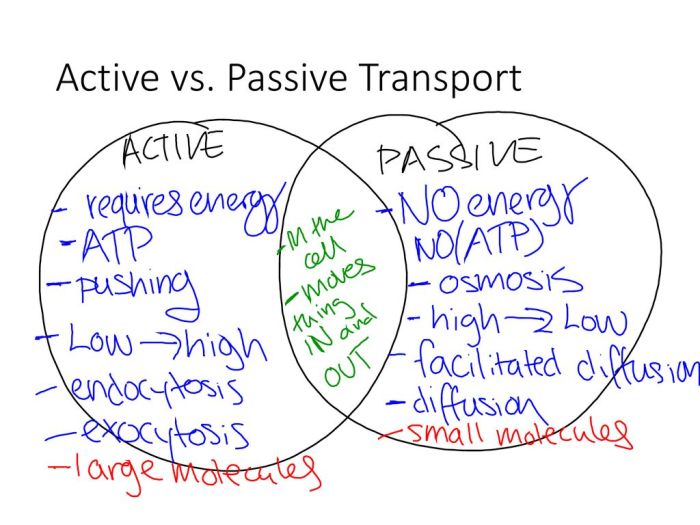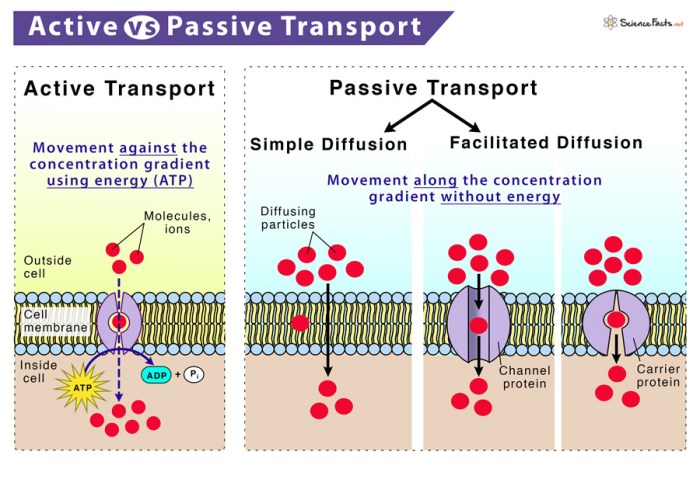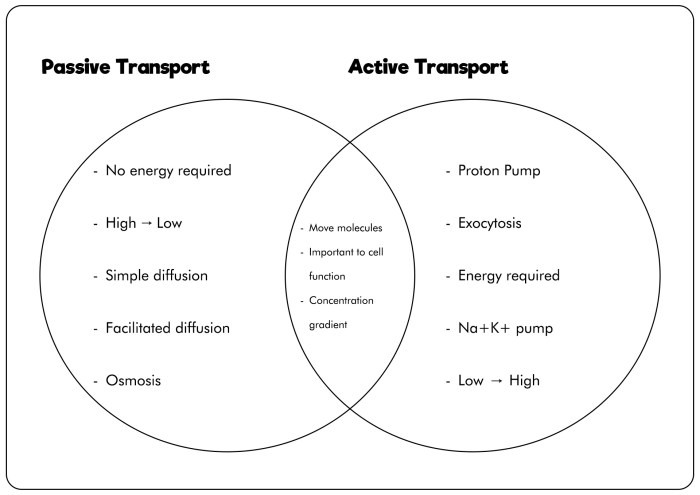Active transport and passive transport venn diagram – Active and passive transport venn diagram presents a comprehensive analysis of the fundamental processes that govern the movement of substances across biological membranes. This captivating exploration delves into the intricacies of these transport mechanisms, revealing their distinct characteristics and the vital roles they play in maintaining cellular homeostasis.
The following paragraphs provide a detailed examination of active and passive transport, exploring their mechanisms, energy requirements, and significance in biological systems.
Active and Passive Transport: Active Transport And Passive Transport Venn Diagram

Active and passive transport are two fundamental processes that govern the movement of molecules across cell membranes. Active transport is an energy-dependent process that moves molecules against their concentration gradient, while passive transport is an energy-independent process that moves molecules down their concentration gradient.
Active transport is essential for maintaining cellular homeostasis, as it allows cells to take up nutrients and expel waste products against their concentration gradients. Passive transport, on the other hand, is essential for the exchange of gases and other small molecules between cells and their environment.
Active Transport
Active transport is carried out by carrier proteins embedded in the cell membrane. These proteins bind to molecules on one side of the membrane and transport them to the other side. The energy required for active transport is derived from ATP hydrolysis.
- Examples of active transport include the uptake of glucose into cells, the export of sodium ions from cells, and the maintenance of a proton gradient across the mitochondrial membrane.
- Carrier proteins are specific for the molecules they transport. Each type of carrier protein has a binding site for a particular molecule.
- The energy requirements of active transport vary depending on the molecule being transported and the concentration gradient.
Passive Transport
Passive transport is the movement of molecules across a cell membrane down their concentration gradient. This process does not require energy, as the molecules move from an area of high concentration to an area of low concentration.
- Examples of passive transport include the diffusion of oxygen into cells, the diffusion of carbon dioxide out of cells, and the osmosis of water across a semipermeable membrane.
- Concentration gradients are the driving force for passive transport. The greater the concentration gradient, the faster the rate of passive transport.
- There are three main types of passive transport: diffusion, osmosis, and facilitated diffusion.
Venn Diagram of Active and Passive Transport, Active transport and passive transport venn diagram
The following Venn diagram compares and contrasts active and passive transport:
- Similarities:Active and passive transport both involve the movement of molecules across cell membranes.
- Differences:Active transport is an energy-dependent process that moves molecules against their concentration gradient, while passive transport is an energy-independent process that moves molecules down their concentration gradient.
Popular Questions
What is the primary difference between active and passive transport?
Active transport requires energy to move substances against a concentration gradient, while passive transport does not.
What is the role of carrier proteins in active transport?
Carrier proteins bind to specific substances and facilitate their movement across the cell membrane.
What are some examples of passive transport?
Diffusion, osmosis, and facilitated diffusion are all examples of passive transport.

